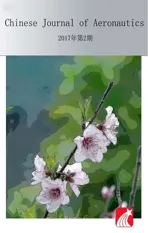Tracking characteristics of tracer particles for PIV measurements in supersonic flows
2017-11-20ChenFngLiuHongYngZifengHuHui
Chen Fng,Liu Hong,Yng Zifeng,Hu Hui
aSchool of Aeronautics and Astronautics,Shanghai Jiao Tong University,Shanghai 200240,China
bDepartment of Mechanical and Materials Engineering,Wright State University,Dayton,OH 45435,USA
cDepartment of Aerospace Engineering,Iowa State University,Ames,IA 50011,USA
Tracking characteristics of tracer particles for PIV measurements in supersonic flows
Chen Fanga,*,Liu Honga,Yang Zifengb,Hu Huic
aSchool of Aeronautics and Astronautics,Shanghai Jiao Tong University,Shanghai 200240,China
bDepartment of Mechanical and Materials Engineering,Wright State University,Dayton,OH 45435,USA
cDepartment of Aerospace Engineering,Iowa State University,Ames,IA 50011,USA
Particle Image Velocimetry(PIV);Seeding;Supersonic flow;Tracers;Tracking characteristics
The tracking characteristics of tracer particles for particle image velocimetry(PIV)measurements in supersonic flows were investigated.The experimental tests were conducted at Mach number 4 in Multi-Mach Wind Tunnel(MMWT)of Shanghai Jiao Tong University.The motion of tracer particles carried by the supersonic flow across shockwaves was theoretically modelled,and then their aerodynamic characteristics with compressibility and rarefaction effects were evaluated.According to the proposed selection criterion of tracer particles,the PIV measured results clearly identified that the shockwave amplitude is in good agreement with theory and Schlieren visualizations.For the tracer particles in nanoscales,their effective aerodynamic sizes in the diagnostic zone can be faithfully estimated to characterize the tracking capability and dispersity performance based on their relaxation motion across oblique shockwaves.On the other hand,the seeding system enabled the tracer particles well-controlled and repeatable dispersity against the storage and humidity.
1.Introduction
The occurrence of shockwaves with physical interruption in compressible flows,where a significant flow deceleration occurs across a very thin region,challenges the applications of measurement techniques.1With the appearance of short interframing-time CCD cameras and nanosecond-duration double-pulsed Nd:YAG lasers,the recent extension of PIV technique in supersonic flows becomes mature and practical.Haertig et al.2performed nozzle calibration measurements in a shock tunnel at Mach number 3.5 and 4.5.Scarano3conducted a series of investigation on supersonic turbulent wakes as well as shockwave turbulent boundary-layer interaction.A challenging application of particle image velocimetry(PIV)was pioneered by Schrijer et al.4,5to investigate the flow over a double ramp configuration in a Mach number 7 flow.Schrijer and Walpot6pointed out that the reliability of PIV applications under extreme high-speed conditions demands smaller relaxation time of the tracer particles.Nanoparticlebased planar laser scattering(NPLS)method7was alsodeveloped to demonstrate the tracking ability of nanoparticles to capture the space-time structure in supersonic flows.
The quantitative determination of the particle tracking characteristics is commonly conducted by PIV measurements with the evaluation of the particle response time across a stationary shock wave.Earlier study demonstrated a response time of 3–4 ls for TiO2and more than 20 ls for Al2O3particles.8Another PIV measurement claimed a relaxation time below 2 ls for TiO2particles from the particle velocity profile downstream of an oblique shockwave.9Then,the nanostructured Al2O3aggregates around 10 nm in diameter yield a relaxation time of 0.27 ls,which is an order of magnitude reduction with respect to the compact TiO2nanoparticles.10A more recent discussion is given by Ragni et al.11,who obtained the relaxation time of different solid particles in the range of 0.4–3.7 ls based on a systematic investigation.However,few investigation takes the characterization of compressibility and rarefaction effects into consideration.This motivates the present efforts to experimentally and theoretically analyze the particles’motion allowing for measurement conditions variation to develop the seeding-particle-selection and seeding-distribution techniques within a higher Mach number regimes.
The experiments were conducted by PIV techniques in Multi-Mach Wind Tunnel(MMWT)of Shanghai Jiao Tong University(SJTU).The tracer particles’motion across a shockwave was theoretically modelled considering compressibility and rarefaction effects and then experimentally analyzed from PIV measurements.It can yield qualitative information on particles’motion to estimate the available size of tracer particles in selection before experiments and analyze their effective aerodynamic diameters after experiments.In order to reach the requirements for tracer particles,advances in the seeding system integrating a pressurized vessel with a fluidized bed enabled the seeded particles to track the supersonic flows.
2.Experimental apparatus and procedure
Fig.1 shows the diagram and components of MMWT,which is capable of providing supersonic and hypersonic flows with nominal Mach numberMa1=2.5,3,4,5,6,and 7,respectively.The blowdown-suction operation pattern extends the test duration time up to 20 s.The present experiments to analyze the characteristics of particles are operated at the freestream condition of nominal Mach number 4.The velocity of the supersonic mainflow in the test cabin is 800 m/s with total pressure of 0.5 MPa and total temperature of 400 K.
2.1.PIV system setup
Fig.1 shows a double-frame digital PIV system composed of the laser,CCD camera,and synchronizer.The solid-state frequency-doubled Nd:YAG laser with a wavelength of 532 nm has a nominal energy of 500 mJ(stability±4%)per pulse.Lasers are available with pulse width about 5 ns,and repetition rate of 1–10 Hz.The test cabin holds three windows with 200 mm diameter,which can be optically accessible for PIV measurements.PIV pictures within the illuminated region are taken from the front view by an IPX-11M CCD camera(4000-2672 pixels,11 M resolutions,12 bits).The camera uses high-performance progressive-scan interline CCD chips,capable of acquiring two images with a minimum pulse separation of 200 ns and framing rate of 5 Hz.The time interval between pulses is a critical parameter,i.e.the particles moving timet,for matching the PIV system to the flow velocity.The particle images are recorded at 5 Hz resulting in 50 image pairs per tunnel run.A 105 mm SIGMA lens atf#=2.8 is carefully chosen to gain the particle images with sufficient collected energy and reduce the image blur due to aero-optical aberrations.The camera is fitted with a narrowband-pass 532 nm filterto minimizeambientlightinterferenceand almost tangential to the wall to alleviate the reflections.
2.2.Particles’seeding technique
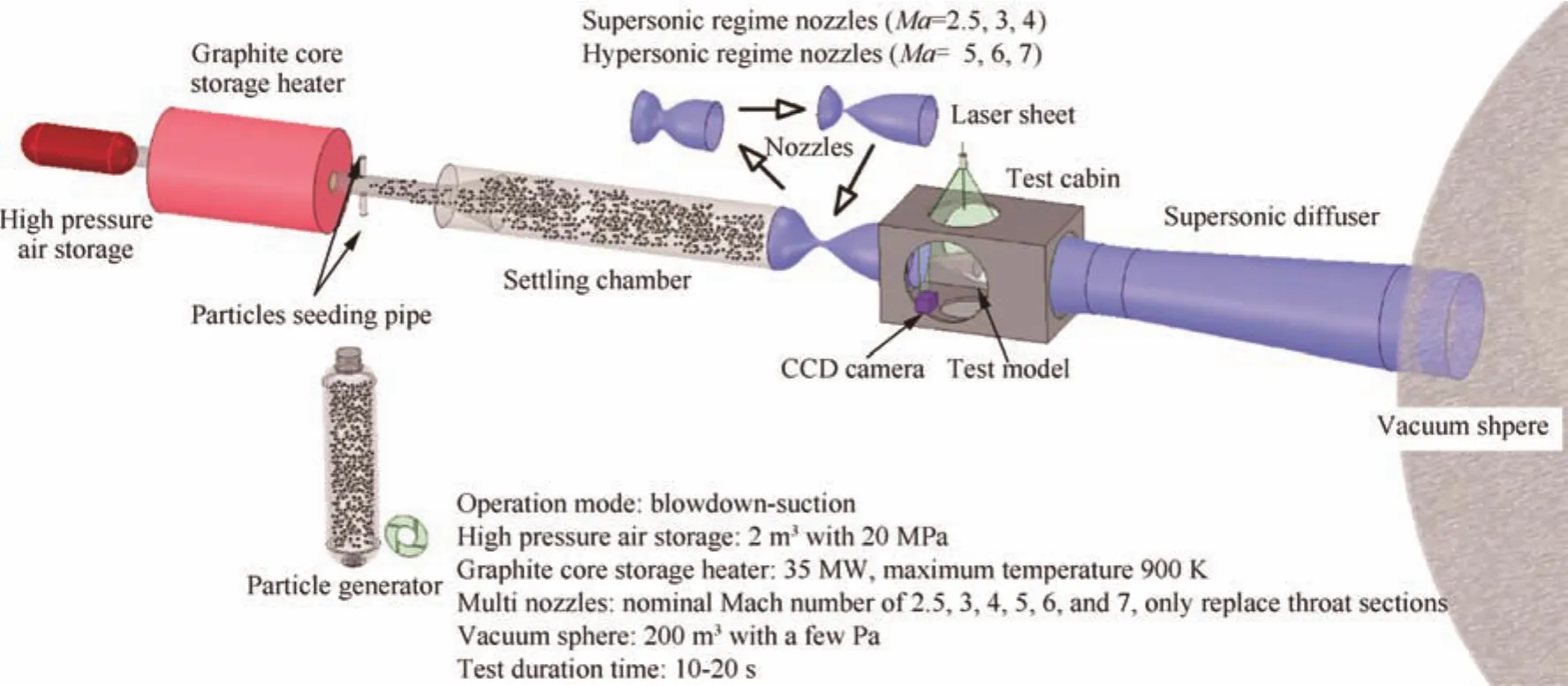
Fig.1 Multi-Mach numbers wind tunnel(Ma1=2.5–7)and PIV system setup.
Fine and non-agglomerated particles are required for PIV measurements under the extreme high-speed conditions.TiO2particles with nominal diameter of 30 nm are chosen as the tracers in the present flow measurement.However,the humidity and prolonged storage make these particles a strong tendency to form agglomerates several times larger than the primary sizes.A tracer particles’seeding system is newly designed to disperse the particles(Fig.2).The interactive force among the particles resulted from the charge of solid tracer particles will be negligible next to nothing in consideration of the electric conductivity of the metallic particle seeding device.In contrast,a mechanism is developed to disperse the dehydrated powders in a fluidized-bed like device in a oncemolded vessel with high tensile and compressive strength of 16 MPa,which is driven by a swirling dry air jet with both high pressure gradient and high momentum.It is expected to ensure particles fully mixing with the flow and to make the aerosol(the mixture of air flow and suspended particles)uniformity in the PIV measured region.This device also vastly simplifies the process to supply and clean the particles during the experiments.The jet flow with 2 MPa beyond the mainflow will provide a suitable flow rate of 0.01 kg/s carrying the seeding particles,yielding appropriate concentration among several preliminary runs.
3.Characteristic analysis of tracer particles
3.1.Tracers’motion across a shockwave

wheretis the tracer particles’moving time and s the relaxation time to qualify the particle’s response.It is characterized in terms of the drag coefficientCDas

The particle Reynolds numberRepis dictated with respect to the relative velocity between the particle velocity and the gas velocity far from the particle surface as:

where l is dynamic viscosity of the flow,and qpanddpare the density and diameter of the particle,respectively.
The experimentally inferred particle relaxation time s becomes a crucial factor for the velocity measurement in high-speed flows.When a particle with initial velocityUp(0)is seeded into the flow,the particle will accelerate with the surrounding flow at the rate of 1/s.The corresponding velocityUp(t)gradually increases close to,but never up to the flow velocityU.Similarly,the tracer particles across a shockwave,as shown in Fig.3,decelerate with an exponential decay to follow the actual flow streamlines downstream of the shockwave in a finite time instead of a theoretical discontinuity at the shockwave.Here,a dimensionless velocityU*,i.e.,the slip velocity of a particle is defined as

where e is natural logarithm,Upn(t)is specified as the normal velocity of the particle,Un1andUn2represent the normal velocity of the flow before and after the shockwave.It is assumed that all seeded particles would be well-mixed and uniform while they travel till the vicinity of the shockwave.

Fig.2 Tracer particles’seeding system.
Further information regarding the response of particles across shockwaves can be found in Dring13or Tedeschi et al.14Such a procedure was adopted in the previous investigations2,15,16to obtain the velocity profile across a planar oblique shockwave,following the fact that the tracer particles decelerate gradually due to inertia.9In those supersonic flow tests are conducted over the wedge with a small deflection angle,5,10,11the induced shockwave strength i.e.normal Mach number is typically lower than 1.4.By treating the particle’s deceleration across a shock in a piecewise way,the relaxation is always given to be approximately linear11as follows:

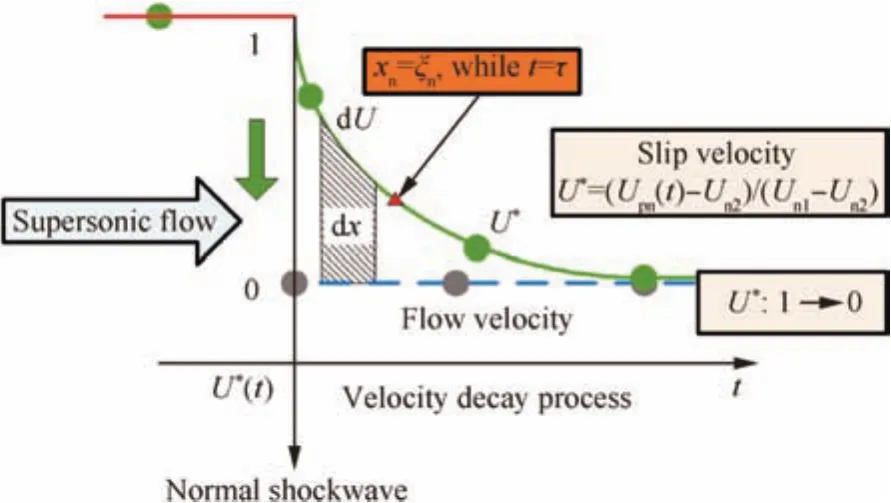
Fig.3 Motion of tracer particles across a shockwave in supersonic flows.


where the particle relaxation distance

Obviously,the dimensionless displacementx*always obeys the relationship with the dimensionless slip velocityU*in Eq.(6),which is determined by the ratio oft/s.In general,the present model of Eq.(6),which properly represents the particles relaxation process regardless of the effects of shockwave strength,has outperformed the empirical expression of Eq.(5).
By using the normal shockwave relations,Eq.(7)can be clearly changed into


3.2.Particles selection criteria
By revealing the effects of time ratiot/s,i.e.,slip velocityU*of the particles on the dimensionless displacementx*,a semielasticity concept,17also as a popular economic tool,is introduced to analyze the responsiveness of a function to changes in parameters.Algebraically,the semi-elasticitySof a functionfat pointxis

Generally,semi-elasticity indicates variables sensitive to a percentage change,which is useful to evaluate how the change in slip velocityU*affects the particle dimensionless displacementx*.From this point of view,the semi-elasticity of dimensionless displacementx*is dominated by the variable slip velocityU*as the following equation:




It should be noted that this linear dependence of drag on the relative velocity is only available to the incompressible and continuum flow,but it represents a conservative estimate of the tracking ability of particles for small relative velocity.Eq.(9)can be therefore greatly simplified:
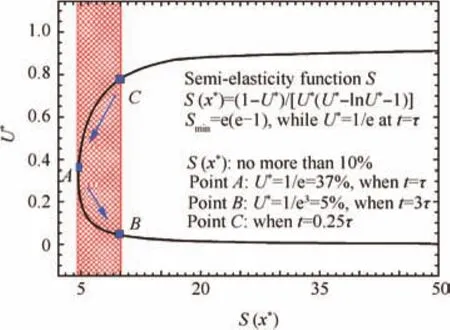
Fig.4 Semi-elasticity of relaxation process for responsiveness of slip velocity.

3.3.Compressbility and rarefaction effects


where c is specific heat ratio of gas flow andRis gas constant.In other words,weaker relative Mach number shows better tracking performance.Considering the low density of gas flow,which usually appears under supersonic simulation conditions,the particle Knudsen numberKnpis no longer small.It is defined as the ratio of the mean free path of the surrounding molecules to the particle diameter,which can be written in terms of the particle Mach number and Reynolds number as



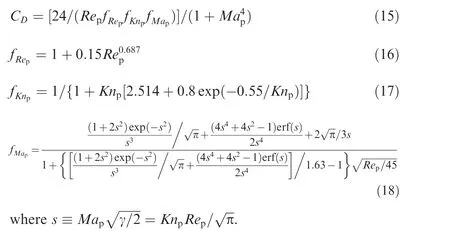
This expression with correction factors of Eq.(15)has been proven quite robust in comparison with experimental and DSMC data.Fig.5 illustrates the compressibility and rarefaction effects on the drag coefficient within the concerned range of governing parameters from Table 1.Also shown in Fig.5 is the probable parameter ranges for present PIV measurements.For these conditions in the present study,the drag coefficient is dominated by the variation of particle Knudsen numberKnp.Besides,the effect of particle Mach numberMapis small but not negligible.Since the magnitude of the relaxation time is primarily dependent on the particle size,this accurate estimate of the particles relaxation is also constrained by appropriate particle tracking.It can be clearly seen that the actual drag coefficient tends to be smaller than Stokes’resistance so that Eq.(11)would conservatively estimate the desired size of the tracer particles for tracking the flow across a shockwave.According to Eqs.(2)and(15)and the probable parameters of the present study,the corresponding diameter of tracer particles is preliminarily calculated as only approximately the onefifth of the overrated value from Eq.(11)for the same relaxation time s.

Table 1 Flow regimes for PIV measurements in supersonic flows.

Fig.5 Rarefaction and compression effects on drag coefficient of a particle in thermal equilibrium,expressed in Eqs.(15)–(18)by Loth22for Rep<45.



Fig.6 Relaxation process across an oblique shockwave in Mach number 4.0 flow.
4.Results and discussions
The calibration tests have been firstly performed in the empty wind tunnel operation at freestream Mach number 4.A pair of images is analyzed with cross-correlation algorithm using Micro Vec2 software employing 32×16 pixels with 50%overlapping.The resulting time-averaged velocity vector distributions of tracer particles are also compared to calculated values from total pressure rake.A rather homogeneous velocity field in spatial distribution is demonstrated in the core flow.The averaged PIV measured velocity field for free stream is very close to the calculated velocity with the uncertainty of less than 2%.16TiO2particles with a nominal crystal size of 30 nm showing better dispersity are finally used.
The present work assumes ideal imaging and tracking conditions,i.e.,pixelization effects are neglected.The time intervaltbetween exposures is set as 500 ns,which is assumed small enough to neglect the time averaging effect on the velocity.Furthermore,the averaging effect of the finite interrogation window size is neglected as well.The velocity considered is that of the particle,which may differ from the actual local flow velocity due to particle relaxation.The magnitude of the velocity error is reduced in the measurement by amplitude modulation in the cross-correlation.The velocity vector field is calculated from 200 image pairs in several repetition runs to minimize the position and velocity error due to any shock movement or displacement of the field of view.



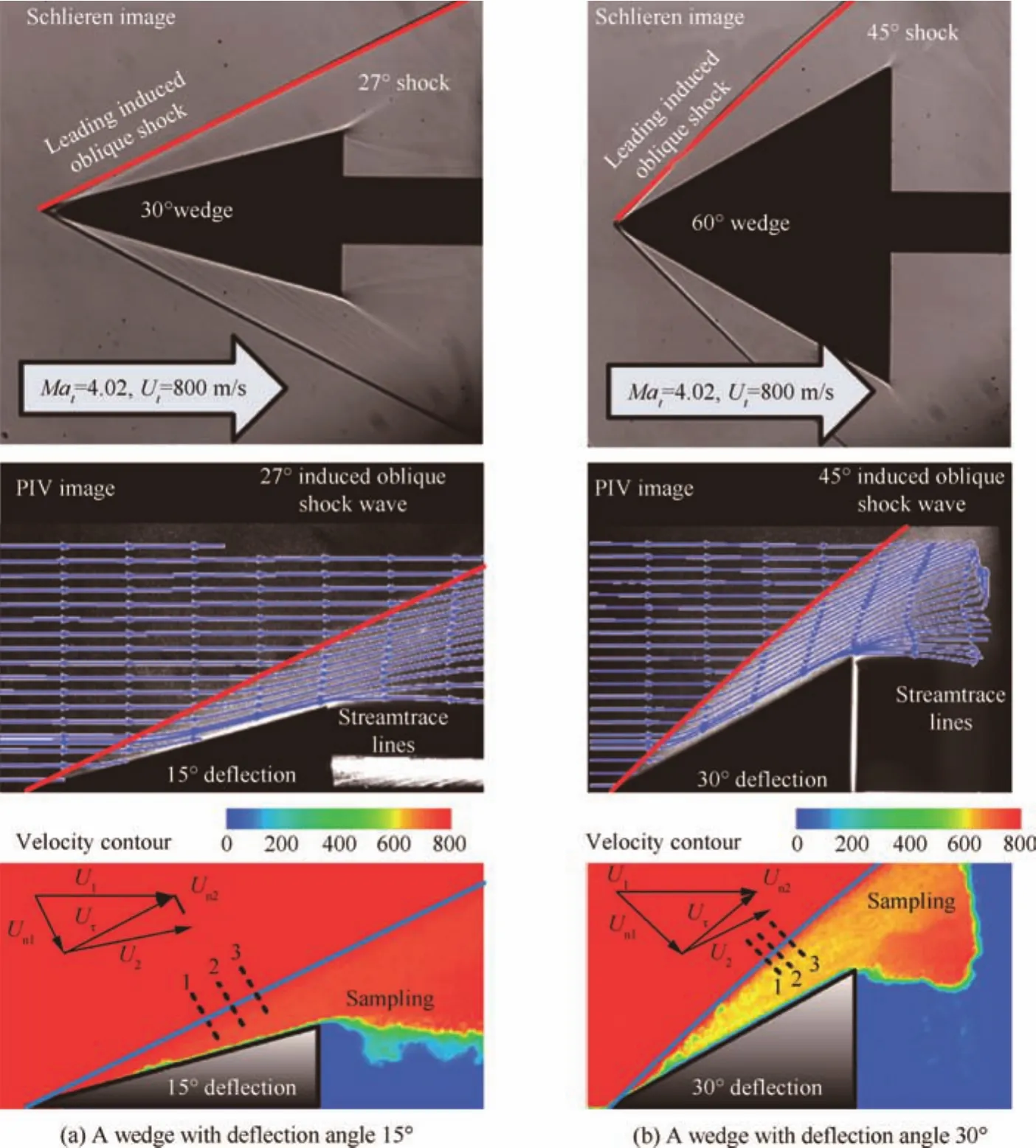
Fig.7 PIV images and measured flow field over 2D wedge models vs Schlieren images.

Table 2 Induced shockwave characteristics over wedge models.

Since the storage and humidity tends to cluster the seeding particles as porous agglomerates,these particles are found to be approximately 200 nm inspected by a scanning electron microscope(SEM)imaging.SEM can only be used to the geometric features of the compact agglomerates in the seeding system before dispersing into the main flow.However,owing to the inevitable agglomeration in the seeding process,the actual aerodynamic diameter of the tracking particles accessible to the test section,which determine the relaxation process across a shockwave,is still unknown.It is noteworthy that the combination of Eqs.(2),(6),(7)and(15)–(18)can qualify the effective aerodynamic diameter of the tracer particles based on the collected velocity distributions.The particle relaxation time s across the incident shockwave can be easily analyzed according to Eq.(7).The relaxation time is mainly dependent on the size of primary particles,although there may be a distribution of particle with variable sizes.Note that the no-shielding assumption exists while the primary particles size is much smaller than the mean free path of the gas molecules.Moreover,the particles in nanoscales present much more stable illumination.As a matter of fact,the applied particles for two wedge models may be considered as the similar size due to the same kind of particles,seeding system and wind tunnel.In practice,the relation between the relaxation time and the corresponding size renders us a possibility for investigating the particles size from PIV measurements across the shockwave.
The particles tracking performance and seeding efficiency are therefore evaluated.By performing an iteration based on Eqs.(2),(6)and(7)integrated with Eqs.(15)–(18),which is robustly fit to the rarefaction dominated regime as discussed before,the particle size can be obtained.It is noted that this value is unable to attain directly in that the particle relative parameters,Rep,Knpare highly dependent on the unknown particle diameter.Attributable to the compressibility and rarefaction effects,the actual particle size in the experiments for both models is evaluated to be almost the same,40 nm for 15°wedge and 50 nm for 30°wedge,respectively.In comparison with the other calculations,all the estimated results of the particle size rounded to the nearest 10 and the corresponding flow parameters are listed in Table 3.It can be seen in Fig.9 that a significant difference in the particle sizes for the?two wedges,which is calculated from empirical Eq.(5),also gives a clear disproof for its limited reliability.On the other hand,Eq.(11)approximately five times overrates the particle size as the actual drag coefficient tends to be lower than Stokes’drag law so that it is also proven unreasonable.
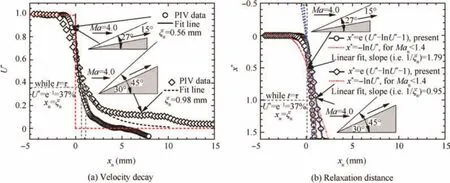
Fig.8 PIV measurement of normal velocity across shockwave.

Table 3 Relaxation time and diameter analysis of tracer particles.
Interestingly,the estimated size of the tracer particles is found to be very close to their nominal diameter,even though the limitation of the PIV spatial resolution is considered.This value is greatly smaller than SEM inspection data,which only respects the storage status as a result of inevitable humidity and carriage.Therefore,the seeding system demonstrates a great capability to mitigate the agglomeration of tracer particles.On the other hand,TiO2particles with nominal 30 nm diameter are proven as the candidate with better tracking characteristics with negligible agglomeration.In general,the tracking deviation of particles may slightly influence the measurement of the shock thickness,whereas the particles can capture the actual flow field over a wedge with a relatively accurate velocity before and after the shockwave.

Fig.9 Aerodynamic diameters of seeding particles.
5.Conclusions
(1)An extension of particles response model is proposed for supersonic research compared to the traditional model limited toMan<1.4 regime.The criterion of selecting appropriate particles is described to satisfy the relationship of the relaxation time:t/s=0.25–3.00.The desired particles to ensure effective capturing of the flow field under well-controlled conditions of Mach number 4 should be approximately 20–50 nm in diameter with the time intervalt=500 ns in consideration of compressibility and rarefaction effects.
(2)Powders of TiO2particles with 30 nm diameter are used inthe presentworkfor PIV measurements.The advances in the seeding system by integrating a pressurized cyclone with a fluidized bed demonstrate a distinct improvement of seeding performance.These tracers in nanoscales for PIV measurements prove successful to capture the actual flow field over a wedge with a relatively accurate velocity before and after the shockwave.That the actual size of tracer particles is estimated to be very close to their nominal diameter shows a high dispersity efficiency of the seeding system.
Acknowledgements
This study was supported by the National Natural Science Foundation ofChina (Nos.11672183,91641129 and 91441205).
1.Scarano F.Overview of PIV in supersonic flows.Top Appl Phys2008;112(1):445–63.
2.Haertig J,Havermann M,Rey C,George A.Particle image velocimetry in Mach 3.5 and 4.5 shock-tunnel flows.AIAA J2002;40(6):1056–60.
3.Scarano F.Overview of PIV in supersonic flows.Berlin Heidelberg:Springer;2007.p.445–63.
4.Schrijer FFJ,Scarano F,Van Oudheusden BW,Bannink WJ.Application of PIV in a hypersonic double-ramp flow.Reston:AIAA;2005 Report No.:AIAA-2005-3331.
5.Schrijer FFJ,Scarano F,Van Oudheusden BW.Application of PIV in a Mach 7 double-ramp flow.Exp Fluids2006;41(2):353–63.
6.Schrijer FFJ,Walpot LMGFM.Experimental investigation of the supersonic wake of a reentry capsule.Reston:AIAA;2010 Report No.:AIAA-2010-1251.
7.Wang D,Xia Z,Zhao Y,Wang B,Zhao Y.Imaging of the spacetime structure of a vortex generator in supersonic flow.Chin J Aeronaut2012;25(1):57–63.
8.Urban WD,Mungal MG.Planar velocity measurements in compressible mixing layers.J Fluid Mech2001;431(486):189–222.
9.Scarano F,Van Oudheusden BW.Planar velocity measurements of a two-dimensional compressible wake.Exp Fluids2003;34(3):430–41.
10.Ghaemi S,Schmidt-Ott A,Scarano F.Nanostructured tracers for laser-based diagnostics in high-speed flows.Meas Sci Technol2010;21(10):105403.
11.Ragni D,Schrijer F,Van Oudheusden BW,Scarano F.Particle tracer response across shocks measured by PIV.Exp Fluids2011;50(1):53–64.
12.Melling A.Tracer particles and seeding for particle image velocimetry.Meas Sci Technol1997;8(12):1406–16.
13.Dring RP.Sizing criteria for laser anemometry particles.J Fluid Eng1982;104(1):15–7.
14.Tedeschi G,Gouin H,Elena M.Motion of tracer particles in supersonic flows.Exp Fluids1999;26(4):288–96.
15.Amatucci VA,Dutton JC,Kuntz DW,Addy AL.Two-stream,supersonic,wake flow field behind a thick base.I-General features.AIAA J1992;30(8):2039–46.
16.Chen F,Liu H,Rong Z.Development and application of nanoparticle tracers for PIV in supersonic and hypersonic flows.Reston:AIAA;2012 Report No.:AIAA-2012-0036.
17.Wooldridge J.Introductoryeconometrics:Amodern approach.Mason(OH):Cengage Learning;2012.
18.Stokes GG.On the effect of the internal friction of fluids on the motion of pendulums.Trans Cambridge Philos Soc1851;9(2):8.
19.Koike S,Takahashi H,Tanaka K,Hirota M,Takita K,Masuya G.Correction method for particle velocimetry data based on the Stokes drag law.AIAA J2007;45(11):2770–7.
20.Humble RA,Scarano F,Van Oudheusden BW.Particle image velocimetry measurements of a shock wave/turbulent boundary layer interaction.Exp Fluids2007;43(2–3):173–83.
21.Mathijssen T,Bannink WJ,Scarano F.Investigation of a sharpedged delta wing in a supersonic flow using stereo PIV.Reston:AIAA;2009 Report No.:AIAA-2009-3896.
22.Loth E.Compressibility and rarefaction effects on drag of a spherical particle.AIAA J2008;46(9):2219–28.
6 April 2016;revised 18 September 2016;accepted 29 September 2016
Available online 14 February 2017
*Corresponding author.
E-mail address:fangchen@sjtu.edu.cn(F.Chen).
Peer review under responsibility of Editorial Committee of CJA.
杂志排行
CHINESE JOURNAL OF AERONAUTICS的其它文章
- Dynamics of air transport networks:A review from a complex systems perspective
- ATM performance measurement in Europe,the US and China
- Network analysis of Chinese air transport delay propagation
- Robustness analysis metrics for worldwide airport network:A comprehensive study
- Evolution of airports from a network perspective–An analytical concept
- Methods for determining unimpeded aircraft taxiing time and evaluating airport taxiing performance
